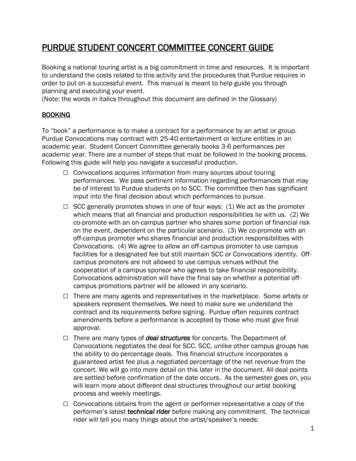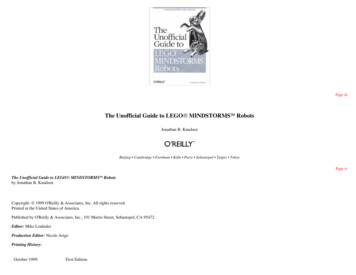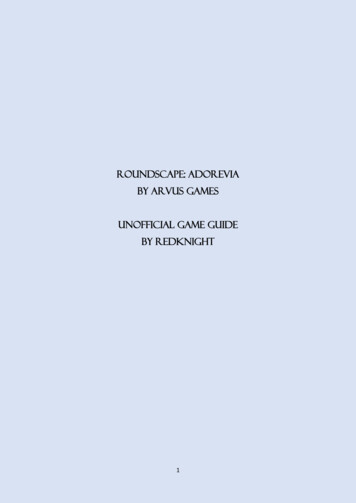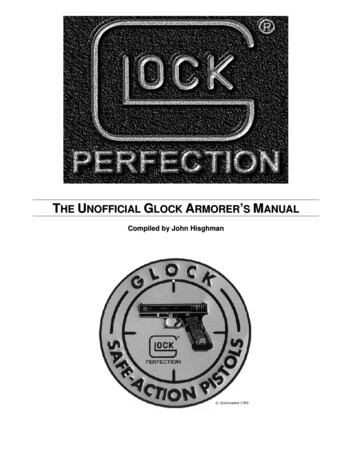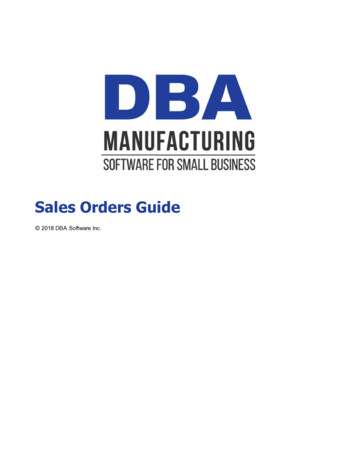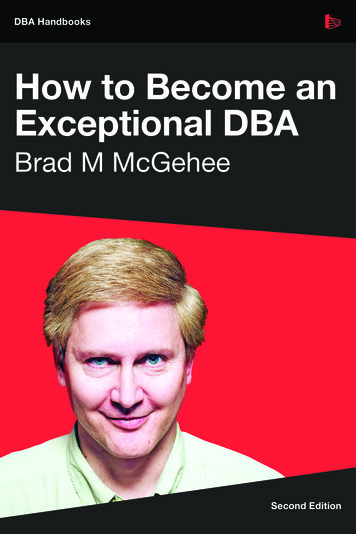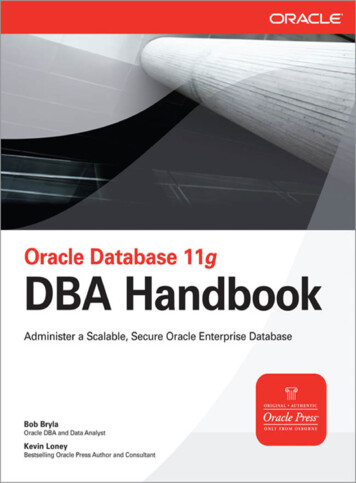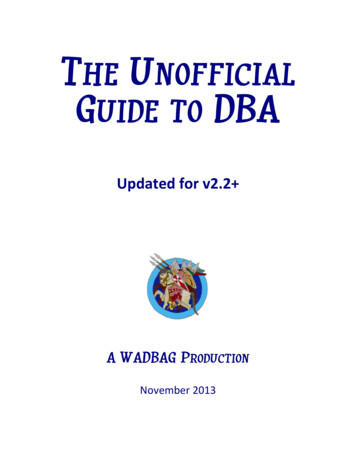
Transcription
THE UNOFFICIALGUIDE TO DBAUpdated for v2.2 A WADBAG PRODUCTIONNovember 2013
The Unofficial Guide to DBAUpdated for v2.2 A WADBAG ProductionNovember 2013The Unofficial Guide to DBA 2006, 2013 Washington Area De Bellis Antiquitatis Gamers.Permission to copy and distribute this document is granted for non-commercial purposes.This guide has not been endorsed or authorized by the authors or the publisher of DBA.
Table of ContentsINTRODUCTION .1GAME MATERIALS .2PLAYING SCALE .3ELEMENTS .4ARMY LISTS .7TERRAIN PIECES .9CAMPS . 11RIVERS . 12SETTING UP A GAME . 13TERRAIN PLACEMENT. 15DISMOUNTING . 17SEQUENCE OF PLAY . 18TACTICAL MOVEMENT . 19PIPS . 20MOVEMENT DISTANCE . 21SINGLE ELEMENT MOVES . 23GROUP MOVES . 24LITTORAL LANDINGS . 28SECOND AND SUBSEQUENT MOVEMENT . 29MOVING THROUGH FRIENDLY ELEMENTS . 30BREAKING OFF FROM FULL FRONT CONTACT . 31ZONE OF CONTROL. 32FULL FRONT, FLANK, AND REAR CONTACT . 35MOVING INTO CONTACT. 36DISTANT SHOOTING . 39CLOSE COMBAT . 43COMBAT RESOLUTION . 46COMBAT RESOLUTION FACTORS . 47COMBAT RESULTS TABLE . 48OUTCOME MOVEMENT . 50EXAMPLES: DISTANT SHOOTING . 55EXAMPLES: CLOSE COMBAT . 56WINNING AND LOSING . 57PRINT AND ON-LINE RESOURCES . 58OTHER STUFF. 59GLOSSARY . 60INDEX . 62
IntroductionHow simple can a set of miniatures rules be andstill hold your interest over time?down and playing a game with an experiencedplayer, having an accessible explanationavailable can only serve to broaden the reach ofDBA.How short can a game be and still give you thesatisfaction of a good contest?Second, we also hope to capture what we see asthe mainstream of how DBA is actually played. Itis written by a group of active players andwritten with the community of active players inmind. If it makes it a little easier for gamers withdifferent backgrounds to play with a commonunderstanding of the rules, then we have beensuccessful in our aim.How few figures can you put on the table andstill feel like a general?The experience of a large group of gamers overthe last twenty years has shown that the rulescan be pretty darn simple, the games very quick,and the armies downright diminutive. Simpleenough for new gamers to learn enough to getstarted in five minutes and feel a reasonablemastery after two or three games. But withenough depth of play to keep players involvedfor more than a decade. Quick enough to getthree or more games in over the space of anevening. And armies small enough for manygamers to collect dozens.v2.2 In September 2012, a group of DBA tournamentorganizers released the v2.2 amendments forDBA. The amendments provide a number ofimprovements to DBA 2.2, while maintainingthe overall feel of play and maintainingconsistency with DBA 2.2 armies. Since thattime, v2.2 has seen widespread adoption and isbeing played worldwide.De Bellis Antiquitatis (a.k.a. DBA) broke onto theminiature wargaming scene in 1990 and thecommunity of dedicated followers has grownsteadily since then. The ideas were new, thegame mechanics worked, and it filled a bigempty space in the wargaming world.Unfortunately, the spread of DBA has alwaysbeen hampered by a cryptic writing style and itslack of clear diagrams and examples. In addition,the ambiguity of the language used has meantthat a common understanding of what the rulesreally mean has been elusive.The Unofficial Guide to DBA attempts to tackleboth of these problems. First, the authors hopethat newcomers to DBA will find it a bit easier tojump in. While there is no substitute for sitting3rd C. BC Spanish Mercenaries (4Ax)The Unofficial Guide to DBA is based on the DBA version 2.2 rulebook with the v2.2 amendmentsapplied. All explanations presented here are consistent with the text of that rulebook as amended. TheBig Battle DBA, Giant DBA, and campaign rules are not covered.See Print and Online Resources (page 58) for information on purchasing a copy of the DBA 2.2 rulebookand downloading the v2.2 amendments.-1-
Game MaterialsWhat do you need in order to play? The basicsare: DiceDBA uses normal six-sided dice.Two playersA game boardAn army for each playerA six-sided die for each playerA measuring deviceA number of terrain piecesMeasuring DevicesYou’ll need some way to measure distances onthe game board. You can make do with a tapemeasure or use specialized playing aids. Acouple of these (a move stick and ZOC marker)are described on the next page.Kibitzers, snacks, and a tasty beverage areoptional.The Terrain PiecesGame BoardThe surface of the game board is by defaultclear and open terrain. To get anything else, youneed to put down a terrain piece. Possibleterrain types include:The game board is a square surface, typicallymade of cloth, felt, or wood. All action takesplace on the game board. The standard gameboard is 30” by 30” for 15mm figures and 48” by48” for 25mm figures. ArmiesEach army consists of twelve troop elements, anoptional camp, and an optional Camp Followerselement. One of the twelve troop elementsmust be designated as the army’s general.So what’s an element? An element is the basicbuilding block of your army. It represents agroup of soldiers (or camp followers) that moveand fight as a single unit.WoodsGentle HillSteep HillMarshRoughWaterwayRiverRoadThese may be represented by a simple piece offelt (inexpensive and functional), or by acarefully built model (visually appealing, butoften a bit of trouble to carry about), oranything in between.Physically, an element consists of a rectangularbase with one or more figures or modelsattached.While the standard game board is now 30” by 30” for 15mm figures, some gamers prefer to continueplaying on the original 24” by 24” board. The smaller board may be more convenient in somecircumstances, but comes at the cost of more “edge-of-the-world” affects. Gamers and tournamentorganizers are free to use whatever size game board fits their preferences.-2-
Playing ScaleFigure ScaleTime and NumbersDBA is played in two basic scales. The first isintended for 15mm figures and the second isintended for 25mm figures. The two differ inelement sizes and the ground scale, but therules are the same.Nominally, each turn in DBA simulatesapproximately 15 minutes of time on thebattlefield and each figure representssomewhere around 250 to 300 men.But given that DBA is a highly abstract game, it’sbest not to place much emphasis on thesenumbers. After all, every DBA army has twelveelements, regardless of the size of thecorresponding historical army. So it’s probablybest to just think of a turn as a turn and anelement as an element and leave it at that.Ground ScaleMost distances are specified in movement units(MU) .1 MU ½ base width.15mm Figures1 MU 20mm25mm Figures1 MU 30mmMeasuring DistancesPlayers may measure distances at any timeduring the game. (Pre-measuring is okay.)To make measuring distances easier, mostplayers use a couple of specialized playing aids:Move Stick. A small stick marked in 1 MUincrements is helpful for measuring movement.ZOC Marker. A square piece of wood or metal,one base width on a side, is used to determine ifan element is within the ZOC of anotherelement. A handle simplifies moving it aroundon a crowded battlefield.ZOC MarkerDBA will work with figures of any scale. For simplicity, the rules explicitly address 15mm figures on40mm wide bases and 25mm figures on 60mm wide bases. But because the number of figures actuallymounted on the base has no affect on the game mechanics, you’re free to substitute any scale figure foreither of these nominal scales. So, whether you like 10mm figures on 60mm wide bases, 6mm figures on40mm wide bases, or any other combination, the rules can be used unchanged.In practice, 25mm is commonly used as a shorthand for all figures of roughly the same size, including20mm plastic figures as well as the 28mm and larger figures that have become common.-3-
ElementsLight Chariots. Cavalry with wheels.We’ll start with a few definitions. Notsurprisingly, every element has a front edge,two side edges, and a rear edge. An elementalso has two front corners and two rear corners.Scythed Chariots. Freaking Psychotic CuisinartScythed Chariots of DOOM!Camelry. They smell bad and they spit a lot.What’s not to like?Front EdgeSideEdgeSideEdgeLight Horse. Quick and agile. Float like abutterfly, sting like a butterfly.Rear EdgeLight Camelry. Float like a butterfly, sting like abutterfly. A butterfly that likes sand.When using 15mm figures the standard elementwidth is 40mm; with 25mm figures the standardelement width is 60mm. The depth depends onthe element type and subtype (see the table onpage 6).Blades. Well armed and well armored, top dogof the foot troops.Raiders. The top dog’s feisty little brother.Spears. Big shields and long pointy sticks.Element CategoriesPikes. Like a big porcupine in a bad mood.There are two broad categories of elements:Mounted and Foot. The Element Table showswhich category each element type belongs to.Light Spears. The big porcupine’s prickly littlebrother.Bows. Bows, crossbows, and longbows enmasse.Element TypesEvery element is of a particular type that reflectsthe historical behavior of the troops beingrepresented. While the name of the elementtype often match
organizers are free to use whatever size game board fits their preferences. -3- Playing Scale . Figure Scale DBA is played in two basic scales. The first is intended for 15mm figures and the secondis intended for 25mm figures. The two differ in element sizes and the ground scale, but the rules are the same. Ground Scale Most distances are specified in movement units (MU) . 1 MU ½ base width .

